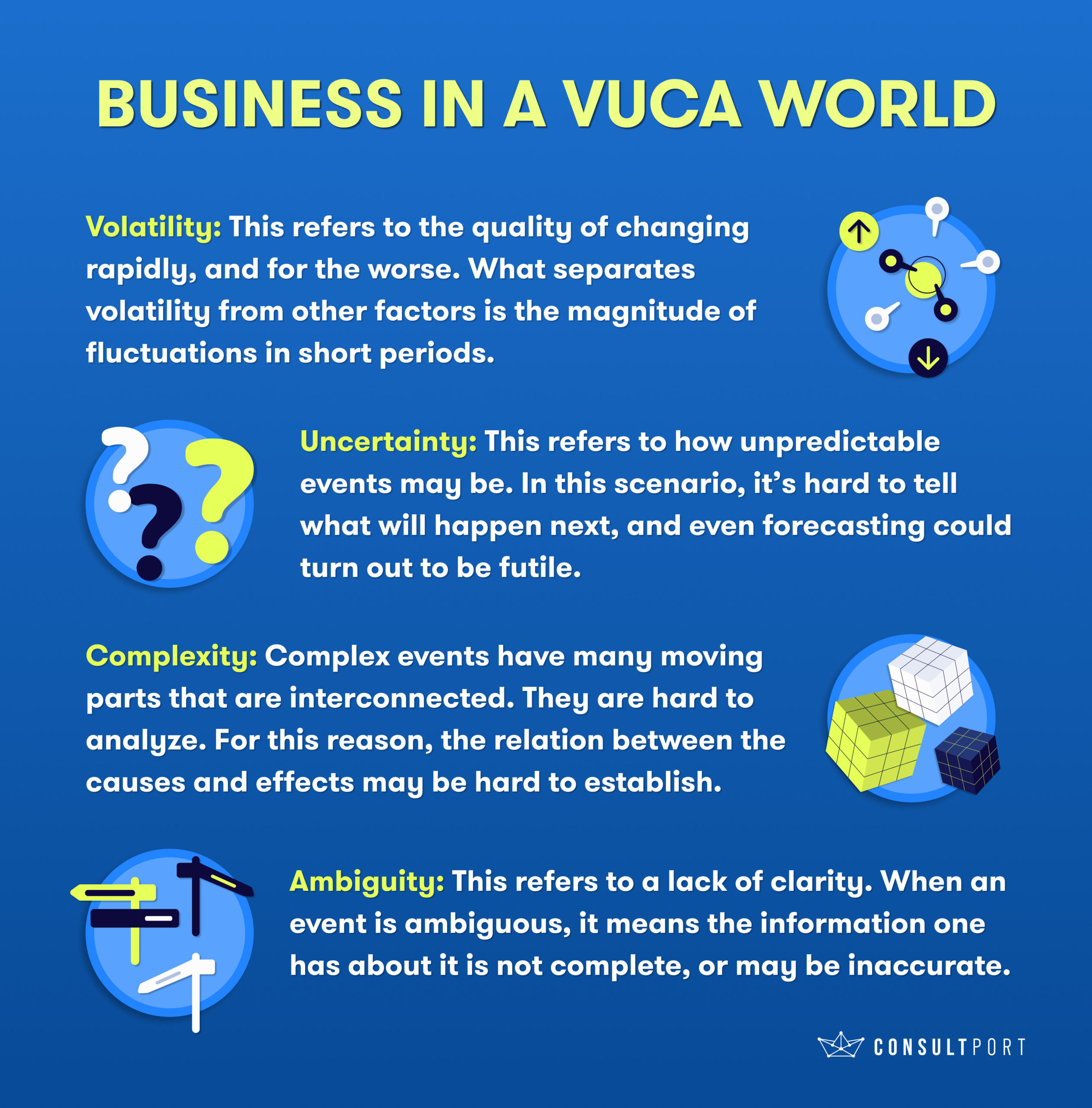Consultants, Here’s How to Create Value in a VUCA World!
Have you noticed how rapidly things change these days? Back in the day, humans went through different eras like the stone age, the bronze age, the iron age, etc., and each era lasted for centuries.
However, those days are gone. Volatility, uncertainty, a lack of clarity, and unnecessary complexity have become the norm in recent years. The phenomenon has also been named, it’s called VUCA.
Now you may be thinking: “Well, it’s bad for business, isn’t it?” The answer is, not necessarily. In this article, we will examine what VUCA is and discuss all its elements briefly. Further, we will talk about the methods to navigate through a VUCA world and how to reach your goals regardless of the external situation.
VUCA: Understanding the Term
VUCA stands for volatility, uncertainty, complexity, and ambiguity. Initially, the term had been used in the early 1990s as a response to the collapse of the USSR.
As the name suggests, VUCA is a term that relates to events that are uncontrollable. The pandemic, as well as the current situation in Ukraine, are perfect examples. They illustrate how totally unprecedented events can turn the world upside down within a matter of weeks.
Likewise, these events can occur in the business world. Therefore, business leaders must know how to create value even when things are not going as planned. In order to achieve that, let’s first understand every element of the term VUCA.
Volatility:
This refers to the quality of changing rapidly, and for the worse. What separates volatility from other factors is the magnitude of fluctuations in short periods. Nevertheless, this doesn’t mean that no information is available about volatile events. Yet, the pace at which these events occur and settle is unpredictable. However, the events themselves may be predictable. Some examples include workers’ strikes, supply chain issues, natural disasters, pandemics, political problems, etc.
Uncertainty:
This refers to how unpredictable events may be. In this scenario, it’s hard to tell what will happen next, and even forecasting could turn out to be futile. When an uncertain event occurs, it may be pretty straightforward to understand what caused it and how it affected the world. For example, Netflix dominated the online streaming market for many years. Then, competitors like Amazon Prime, Hulu, Disney Plus, etc. emerged and took a big share of the market. Recently, Netflix has been in the news as its stock price plummeted significantly—something that many people wouldn’t have predicted.
Complexity:
Complex events have many moving parts that interconnect. They are hard to analyze. For this reason, the relation between the causes and effects may be hard to establish. For example, a corporation with multiple stakeholders may be difficult to manage when all stakeholders have different priorities. Some noteworthy events may happen, but it would be difficult to understand why they happened or who was behind them.
Ambiguity:
This refers to a lack of clarity. When an event is ambiguous, it means the information one has is not complete, or may be inaccurate. Consequently, it is difficult to come to conclusions. For example, if a fast-food chain wants to expand into a new country. In this case, it may have to do so with limited information about that place. In fact, they will only get the full picture once the business is set up.
KEY TAKEAWAYS
- VUCA stands for volatility, uncertainty, complexity, and ambiguity. Generally, it is a term that refers to events that are uncontrollable.
- Consultants can use consulting frameworks and methodologies to help companies operate in such an VUCA world.
- For instance, PESTEL analysis can be of great help while expanding into uncertain, complex, volatile, and ambiguous foreign markets.
- Changes in a VUCA world are common. Thus, consultants must have a deep knowledge of change management methodologies.
- Adopting Agile may be the best way to deal with a rapidly changing business environment.
How to Create Value
Is it possible for businesses to create value in a world that is volatile, uncertain, complex, and ambiguous? One prerequisite is definitely to have a qualified and experienced consultant on board. And that’s where you, as a consultant, come into play. In the following, let’s understand how consultants can use consulting frameworks and models. The goal is to help clients navigate their way through an uncertain business environment and continue to create value.
1. Don’t expand into foreign markets without conducting a PESTEL analysis
If you’re a consultant, you undoubtedly know what PESTEL stands for and how to leverage it. Thus, without getting down to the nitty-gritty of the definition, let’s examine how PESTEL can help in an uncertain business environment. Let’s assume that your client is looking to expand into the Middle East. However, given the political instability in that region, they are a bit hesitant. In this case, you could use the PESTEL analysis to determine which region has the best political and social environment, the required technological infrastructure, and laws that will help facilitate a successful expansion. For instance, you may conclude that Dubai is a stable and advanced area where many foreign businesses thrive.

2. Use change management models to help organizations get used to new changes
Whether an event is volatile, uncertain, complex, or ambiguous, it may require the need for change. It’s not necessarily the quality of being uncontrollable that makes an event problematic. Rather, it is how we react to it that determines its effects. As a consultant, you should be well-versed in change models like the ADKAR model, Lewin’s model, and Kotter’s 8-step model to manage change.
Abrupt changes may cause chaos and affect an organization negatively. Nonetheless, using step by step time-tested models can help companies incorporate changes with efficiency. In this way, an organization will be more likely to continue to create value even when things aren’t going like they’re supposed to.
3. Use Bridges’ Transition model to handle the human side of change
As you may already know, other change models focus only on change. In comparison, Bridges’ Transition model focuses on the human side of change.
It is important to realize that change and transition are different concepts. Change is an event that takes place or is scheduled to take place in an organization. For instance, the commencement of a new production process. Transition, on the other hand, refers to what humans who are affected by change go through psychologically.
Organizations, whether big or small, consist of humans. Consequently, in a VUCA world, it’s important to be well-versed in frameworks like Bridges’ Transition model. This ensures that employees and other stakeholders who may be affected by uncertainty, volatility, or ambiguity have proper support from the company.
4. Use VRIO Analysis to strengthen your client’s company internally
As you may recall, VRIO stands for Valuable, Rare, Inimitable, and Organization. The VRIO framework helps companies perform internal analysis. Furthermore, it helps them understand those elements of their business that put them in an unassailable position on the market. Hence, it can help companies determine a sustainable competitive advantage that is hard to replicate. This includes both tangible and intangible resources.
Tangible resources include physical, financial, organizational, and technological resources. Intangible resources on the other hand include human resources and a firm’s culture, innovation, and repetition resources. Once a company knows what makes it strong, it can focus on strengthening its core competencies further. Accordingly, it can prepare itself for a rainy day.
5. Go Agile
This is by far the best way to deal with unpredictable or uncertain business environments. Even though uncertainty in business is dreaded, Agile makes businesses to look forward to changes and new advancements.
Agile consultants can help companies create processes and workflows that make teams more efficient and better prepared for unforeseeable changes. This is why Agile is a total blessing for industries in which volatility and change are the norms, like software development. With the help of Agile methodologies like Scrum or Kanban, staff can produce working software rapidly and make changes on the go.
This brings us to the end of this article. In conclusion, VUCA may be very beneficial for consultants. The reason is that companies may need their consulting expertise to move through difficult, complex, or uncontrollable situations. However, in order to be able to help clients create value, consultants must know how to use the right framework or model at the right time. And it’s not just the frameworks that we discussed in this article. There are many other things that may be of great help to companies who operate their businesses in the VUCA world.



